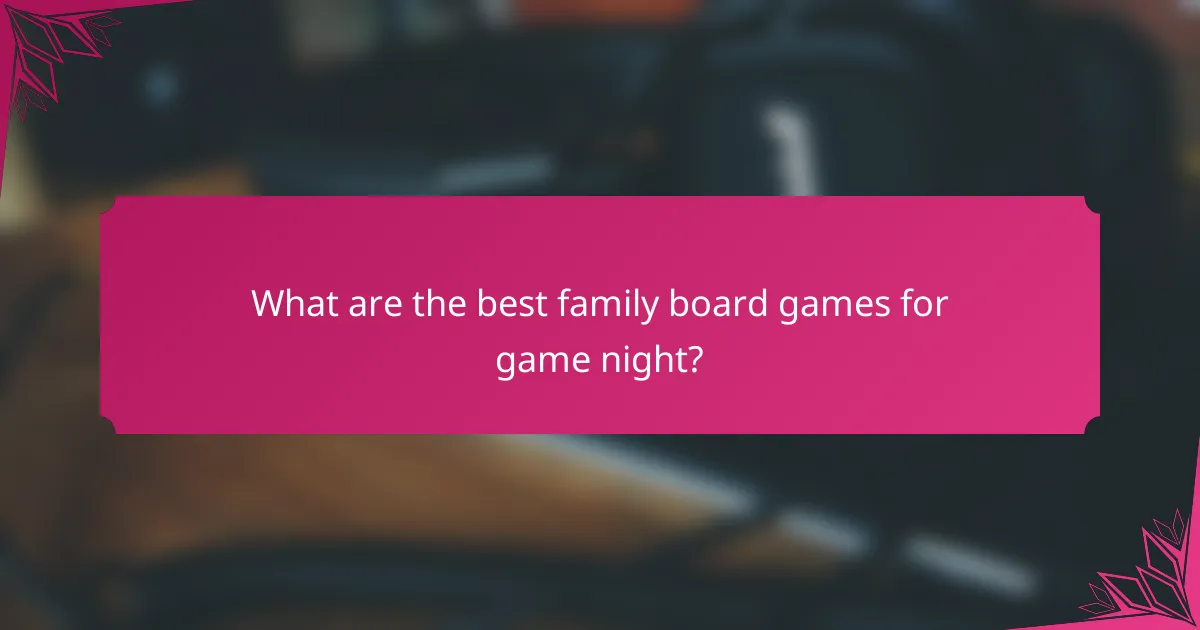Board games serve as a fantastic way to bring families together, fostering interaction and fun during game nights. By choosing games that are easy to learn yet engaging, families can create shared experiences that strengthen bonds and build lasting memories. Consider factors like age appropriateness and complexity to ensure everyone can participate and enjoy the game.

What are the best family board games for game night?
The best family board games for game night foster interaction, strategy, and fun for all ages. Popular choices include games that are easy to learn but offer depth, ensuring everyone can participate and enjoy the experience.
Catan
Catan is a classic strategy game where players collect resources to build roads, settlements, and cities. The game encourages negotiation and trading, making it ideal for family bonding. With a playing time of about 60 to 90 minutes, it suits a variety of ages, typically from 10 and up.
Consider the balance of resource distribution; some players may find themselves with an abundance of one type while lacking others. This can lead to strategic trading opportunities, so be prepared to negotiate effectively.
Ticket to Ride
Ticket to Ride is a train-themed board game that involves collecting cards to claim railway routes across a map. The game is straightforward, making it accessible for families with children aged 8 and older. A typical game lasts around 30 to 60 minutes.
Focus on completing your destination tickets while blocking opponents’ routes. This dual strategy can enhance the competitive aspect of the game, ensuring everyone stays engaged throughout the session.
Carcassonne
Carcassonne is a tile-placement game where players build a landscape with cities, roads, and fields. Each turn, players draw a tile and place it strategically to score points. Suitable for ages 7 and up, games usually last about 35 to 45 minutes.
Pay attention to how tiles connect, as this can significantly impact scoring. It’s beneficial to keep an eye on opponents’ potential points while planning your own moves, creating a dynamic and interactive experience.
Pandemic
Pandemic is a cooperative board game where players work together to stop global outbreaks of diseases. Each player has a unique role, adding strategic depth to the game. It’s best for ages 8 and older and typically takes about 45 minutes to play.
Communication is key in Pandemic; discuss strategies openly to effectively manage outbreaks and develop cures. This collaborative approach can strengthen family bonds as you face challenges together.
Uno
Uno is a fast-paced card game where players aim to be the first to play all their cards by matching colors or numbers. It’s simple to learn, making it perfect for families with children as young as 7. A game usually lasts around 30 to 45 minutes.
Keep an eye on your opponents’ cards and use action cards strategically to disrupt their plans. The element of surprise can turn the tide in your favor, making each round exciting and unpredictable.

How do board games strengthen family bonds?
Board games strengthen family bonds by creating shared experiences that encourage interaction and collaboration. Through gameplay, families can build trust, develop relationships, and create lasting memories.
Encourages teamwork
Many board games require players to work together towards a common goal, which fosters teamwork. Games like Pandemic or Forbidden Island challenge families to strategize and collaborate, teaching them the value of collective effort.
To maximize teamwork, choose games that emphasize group dynamics and require players to communicate effectively. This not only enhances the gaming experience but also strengthens relationships outside of the game context.
Enhances communication
Playing board games naturally enhances communication skills as players must discuss strategies, negotiate, and share ideas. Games that involve bluffing or negotiation, such as Catan or Werewolf, encourage players to articulate their thoughts clearly and listen actively.
To improve communication, select games that require verbal interaction and encourage open dialogue. This practice can lead to better understanding and connection among family members.
Fosters healthy competition
Board games introduce a level of friendly competition that can be both fun and educational. Engaging in competitive play helps family members learn how to handle winning and losing gracefully, promoting resilience and sportsmanship.
To ensure healthy competition, set ground rules that emphasize fun over winning. Encourage players to celebrate each other’s successes and focus on the enjoyment of the game rather than just the outcome.

What factors should you consider when choosing a board game?
When selecting a board game, consider factors such as age appropriateness, player count, game duration, and complexity level. These elements will help ensure that everyone enjoys the experience and that the game fits the group’s preferences and dynamics.
Age appropriateness
Choosing a game that matches the age of the players is crucial for engagement and enjoyment. Games designed for younger children often have simpler rules and shorter playtimes, while those for older players may involve more strategy and complexity.
For example, games labeled for ages 8 and up typically include more intricate mechanics, while those for ages 4 and up focus on basic counting or matching skills. Always check the recommended age on the box to avoid frustration or boredom.
Player count
The number of players a game accommodates can significantly affect the overall experience. Some games are designed for two players, while others can support larger groups, often ranging from three to eight players or more.
Consider the size of your game night gathering. If you frequently host larger groups, look for games that scale well with player count, ensuring that everyone can participate without feeling left out or overwhelmed.
Game duration
Game duration is another important factor to consider, as it impacts how much time you can dedicate to playing. Most board games have an estimated playtime listed on the box, typically ranging from 20 minutes to several hours.
For quick game nights, opt for games with shorter playtimes, ideally under 30 minutes. If you have more time, consider longer games that allow for deeper strategy and engagement, but be mindful of your group’s attention span and schedule.
Complexity level
The complexity level of a game determines how easy or challenging it is to learn and play. Games can vary from simple, quick-to-learn options to more complex ones that require strategic thinking and planning.
When selecting a game, assess the experience level of your players. If you have beginners, choose games with straightforward rules and clear objectives. For more experienced players, consider games that offer deeper strategies and nuanced gameplay to keep everyone engaged.

Where can you buy board games online in the US?
You can purchase board games online in the US through various retailers that offer a wide selection and competitive prices. Popular options include major e-commerce platforms and specialized game stores, making it easy to find both classic and new titles.
Amazon
Amazon is one of the largest online retailers in the US, offering an extensive range of board games from various sellers. You can find everything from family favorites to niche titles, often with user reviews to guide your choices.
When shopping on Amazon, consider checking for Prime eligibility to enjoy free shipping and faster delivery. Additionally, watch for seasonal sales and discounts that can significantly reduce prices.
Target
Target provides a solid selection of board games, both online and in-store, catering to families and casual gamers alike. Their website often features promotions, making it a good option for budget-conscious shoppers.
Look for exclusive editions and bundles that Target sometimes offers, which can include additional game pieces or expansions at a competitive price. Keep an eye on their weekly ads for special deals.
Walmart
Walmart is another major retailer where you can find a variety of board games online. Their inventory includes popular titles and family games, often at lower prices compared to other retailers.
Walmart frequently offers rollback prices and clearance items, so it’s worth checking their website regularly for the best deals. You can also choose in-store pickup to save on shipping costs.
BoardGameGeek Store
The BoardGameGeek Store specializes in board games and gaming accessories, making it a great resource for enthusiasts. They offer a curated selection of games, including hard-to-find titles and expansions.
Shopping here allows you to support a community-driven platform, and you can often find user-generated content and reviews that help inform your purchases. Be mindful of shipping costs, as they can vary based on your location and order size.

What are the most popular board game genres?
The most popular board game genres include strategy games and cooperative games, each offering unique gameplay experiences. Understanding these genres can help families choose games that suit their preferences and enhance their game nights.
Strategy games
Strategy games require players to use critical thinking and planning to achieve objectives. These games often involve resource management, tactical positioning, and long-term decision-making, making them ideal for players who enjoy competition and mental challenges.
Popular examples of strategy games include “Catan,” where players build settlements and trade resources, and “Risk,” which focuses on global domination through strategic military movements. When selecting a strategy game, consider the complexity and the average playtime, which can range from 30 minutes to several hours.
Cooperative games
Cooperative games encourage players to work together towards a common goal, fostering teamwork and communication. In these games, players typically face challenges set by the game itself, requiring collaboration to succeed.
Examples of popular cooperative games include “Pandemic,” where players work to stop global outbreaks, and “Forbidden Island,” which involves retrieving treasures from a sinking island. When choosing a cooperative game, look for ones that match your group’s size and skill level, as many games accommodate various player counts and difficulty settings.
